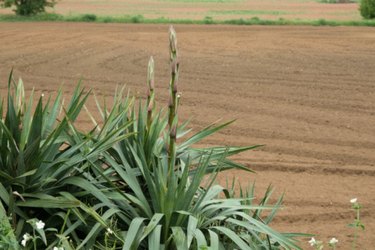
Yuccas are a perennial succulent plant in the agave family. Native to the hot, dry areas of North and Central America and the Carribbean, there are over 49 species and 29 subspecies of yucca that have been described so far. They are characterized by their stiff, sword-shaped leaves with a tall stem of white flowers emerging from the center. While yuccas make an ideal ornamental and medicinal plant, they are susceptible to disease.
Brown Spot
Video of the Day
Caused by the Coniothyrium concentricum fungus, Brown Spot is characterized by yellow and brown spots, or lesions, which appear on the plant's older leaves. Usually a purplish-black border appears around these lesions, and older ones may look completely black and slightly sunken into the leaves' surface. The lesions frequently grow together, causing entire sections of the leaf to die. Prevent brown spot by watering from the bottom, and keep the yucca in a dry location with no standing water or overly damp soil. Control the disease by removing and disposing of infected leaves and by using fungicides that contain mancozeb or chlorothalonil.
Video of the Day
Gray Leaf Spot
Gray leaf spot is found mostly on the Spanish Bayonet yucca and is caused by the fungus Cytosporina sp. The tips and edges of the leaves begin to die and turn gray with a brown margin. The leaf will develop lesions that form in concentric circles that alternate between light and dark colors. These lesions can reach up to 3 inches in diameter. Avoid overhead watering, and keep your yucca away from wet areas. Control the disease by removing infected leaves and vigilantly using pesticides.
Fusarium Stem Rot
This disease is commonly seen in yuccas. The end of the plant's stem begins to turn soft and rot, which eventually spreads to the leaves. The infected areas of the plant will develop round red perithecia and ochre-colored groups of conidia; these are the fruiting bodies of the fungus. No fungicides have proven effective for fusarium; control the disease by using only pathogen-free soil and by using only sterilized gardening equipment.
Southern Blight
Southern blight is mostly visible on the stem but actually attacks the entire plant. Caused by the fungus Sclerotium rolfsii, coarse white threads, called mycelia, grow on the plant -- and occasionally the soil -- in a fan shape. Circular lesions, called sclerotia, form on the plant. Sclerotia start out white and then turn dark brown as they mature and get ready to go to spores. Control the disease by using good garden hygiene; cut off any affected areas, and bag or burn to prevent spreading. You can also use a fungicide that contains PCNB.
Cercospora Leaf Spot
Caused by the Cercospora sp., a relative of Fusarium sp., this disease causes rust-colored freckles on the leaves. These freckles quickly grow to 1/4 inch and turn brown. You can control this disease by watering from the bottom to prevent spores from spreading. Remove and burn any affected leaves. You can also use a fungicide that contains thiophanate methyl.
- University of Arkansas Cooperative Extension: Plant Health Clinic News
- University of Florida IFAS Extension: Yucca Production Guide
- University of Arizona Cooperative Extension: Problems and Pests of Agave, Cactus and Yucca
- The Horticultural Site: Common Diseases and Disorders of Sansevieria and Yucca